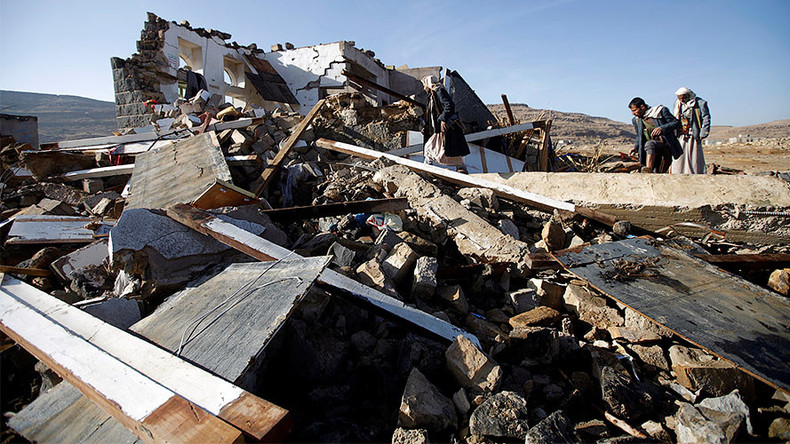
US and European Allies Supply about 75% of the Weapons in the Region
Dave DeCamp / AntiWar.com
(September 24, 2020) —A new report from the Center for International Policy (CIP) found that from 2015 to 2019, the US was the number one supplier of weapons in the Middle East and North Africa, supplying 48 percent of the region’s arms. Combining the US arms with its European allies, the Western countries provided nearly three-quarters of the weapons used in the area for that period.
The US was the top weapons supplier by a wide margin, with Russia coming in second at 17 percent. The next four leading suppliers were France with 11 percent, the UK at five percent, Germany at five percent, and China trailed behind exporting three percent of the region’s weapons.
The top recipient for weapons exports was Saudi Arabia. The Kingdom received 30 percent of the weapons transferred to the region. Seventy-four percent of the arms sold to Saudi Arabia came from the US, who is the top provider of weapons for all the Gulf countries.
The CIP study said that proponents for these arms sales describe them as “a force for stability, a way to cement alliances, a way to counter Iran, or, more generally, as a tool for creating a balance of power that makes conflict less likely.”
While US officials invoke the Iranian threat to justify arms sales to countries like Saudi Arabia and the UAE, the reality is, these weapons are mostly used to kill civilians in Yemen and end up in the hands of groups like al-Qaeda.
Besides Yemen, US arms have fueled wars in countries all across the region, in Libya, Egypt, Iraq, and Syria, to name a few. The study found that US arms often end up in the hands of opposing sides in these conflicts.

Western Arms Exports Fuel Conflict in Middle East, North Africa
Tom Allinson and Lewis Sanders IV / MSN
(September 24, 2020) — The US and its European allies make up nearly three-quarters of all arms transfers to the Middle East and North Africa, a new report found. Experts say arms exports to the region fuel conflict and human rights abuses.
Over the past five years, Western countries’ exports made up the bulk of weapons delivered to the Middle East and North Africa, according to a report published this week by the Washington-based Center for International Policy (CIP).
The US leads the way with a share of nearly 50% of all arms transfers to the region, while France, the UK, Germany and Italy comprise 24%. Russia was the second-largest single arms supplier to the region, trailing behind the US with 17% of the region’s arms export market.
The CIP, a think thank that advocates for peaceful international engagement, said that arms exports are often described “as a force for stability, a way to cement alliances, a way to counter Iran, or, more generally, as a tool for creating a balance of power that makes conflict less likely.”
Fueling Conflict
However, small arms deliveries and other military aid have played a key role in perpetuating conflict in the region, William Hartung, the report’s author and director of CIP’s Arms and Security Project, explains.
“Aerial bombardment and the use of long-range artillery have been instrumental in the deaths of tens of thousands of civilians directly, and are indirectly responsible for hundreds of thousands” when the bombing of infrastructure is taken into account, Hartung told DW.
In Yemen, American and British aircraft, bombs, missiles and armored vehicles delivered to Saudi Arabia and the UAE have contributed to a war that has cost more than 100,000 lives.
In Egypt, US-supplied combat planes, tanks and helicopters have been used in “what is supposedly a counterterror operation in the Northern Sinai but, in reality, has become a general war against the civilian population of the region,” the report said.
US weapons have also ended up in the hands of opposing sides of conflicts in Iraq, Yemen, Syria and Libya. Although Russian equipment has also played a large role in fueling conflict in Syria and Libya. The situation in Libya has been exacerbated by weapons deliveries from Turkey and the UAE — with allegations that some of those arms were made in the US, according to the Geneva-based Small Arms Survey.

A Saudi-led coaltion has led airstrikes in Yemen using US and European hardware since 2015.
Sending Arms to Strengthen Alliances?
For advocates of less restricted arms sales to the region, such arms transfers serve to cement alliances and promote stability.
In June, General Kenneth McKenzie, head of US Central Command — one of 11 US combatant commands — said that US arms sales to various Middle East states helps prevent those countries from relying more on Russia and China for their military hardware.
However, other experts believe that even if the US and its European allies moderated arms exports to the region, it is unlikely that Russia or China could exploit the gap due to international measures aimed at containing the proliferation of their arms.
“It would be very difficult for Russia and China to quickly fill the gaping void left by any combined move to reduce arms sales to the region,” says Robert Mason, a fellow with the Sectarianism, Proxies and Desectarianization project at Lancaster University in the UK.
US measures, such as the Countering America’s Adversaries Through Sanctions Act signed by Trump in 2017, would “continue to exert pressure on states that purchase from Russia,” Mason explains.
“China has already experienced secondary sanctions. Turkey may yet be sanctioned for its purchase of the S-400 (missile system) from Russia. Other Russian clients such as India, Egypt and Algeria will have to consider such risks, as will those states which have already embarked on technical cooperation with Moscow, such as Turkey, Saudi Arabia and the UAE.”
Trump touts US arms sales to Saudi Arabia, which activists say fuel war in Yemen.
But experts also warned that US arms exports have only emboldened regimes such as Saudi Arabia and the UAE and that support for oppressive governments have set the stage for future instability in the region.
“We might be getting some short-term gains but in the long term, some very terrible outcomes,” said Jodi Vittori, a scholar at the Carnegie Endowment for International Peace and former Lieutenant Colonel in the US Air Force.

Middle East Key Market for Exporters
The CIP report also highlights how dependent major Western arms producers are on the region’s market, with three of the top five arms suppliers — the US, France and the UK — making more than half of their global arms deliveries to the region. For Germany, the region accounted for half of its arms business.
“The question is, how much strategic security thinking is being used to make decisions about whether to supply weapons to countries in the Middle East,” said Pieter Wezeman, a senior researcher at the Stockholm-based arms monitor SIPRI. “Or is it primarily straight forward economic motives of export revenue and jobs that drives the export of arms to these countries.”
Ahead of the US election on November 3, the CIP report makes a number of recommendations for US lawmakers to limit arms flows and establish oversight in how they are used. But what can European powers do to end their part in fueling conflicts while upholding strategic partnerships in the region?
“It is so important for Western countries to make their arms exports to any region, but particularly the Middle East, truly part of a holistic security policy and make sure that it’s not driven by economic interests,” Wezeman said. “Otherwise it will backfire in the end.”
Posted in accordance with Title 17, Section 107, US Code, for noncommercial, educational purposes.